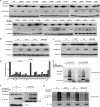FBXO32 Targets c-Myc for Proteasomal Degradation and Inhibits c-Myc Activity
- PMID: 25944903
- PMCID: PMC4481220
- DOI: 10.1074/jbc.M115.645978
FBXO32 Targets c-Myc for Proteasomal Degradation and Inhibits c-Myc Activity
Abstract
FBXO32 (MAFbx/Atrogin-1) is an E3 ubiquitin ligase that is markedly up-regulated in muscle atrophy. Although some data indicate that FBXO32 may play an important role in tumorigenesis, the molecular mechanism of FBXO32 in tumorigenesis has been poorly understood. Here, we present evidence that FBXO32 targets the oncogenic protein c-Myc for ubiquitination and degradation through the proteasome pathway. Phosphorylation of c-Myc at Thr-58 and Ser-62 is dispensable for FBXO32 to induce c-Myc degradation. Mutation of the lysine 326 in c-Myc reduces c-Myc ubiquitination and prevents the c-Myc degradation induced by FBXO32. Furthermore, overexpression of FBXO32 suppresses c-Myc activity and inhibits cell growth, but knockdown of FBXO32 enhances c-Myc activity and promotes cell growth. Finally, we show that FBXO32 is a direct downstream target of c-Myc, highlighting a negative feedback regulation loop between c-Myc and FBXO32. Thus, FBXO32 may function by targeting c-Myc. This work explains the function of FBXO32 and highlights its mechanisms in tumorigenesis.
Keywords: FBXO32; Myc (c-Myc); cell proliferation; muscle atrophy; oncogene; proteasomal degradation; ubiquitylation (ubiquitination).
© 2015 by The American Society for Biochemistry and Molecular Biology, Inc.
Figures








Similar articles
-
FBXO32 suppresses breast cancer tumorigenesis through targeting KLF4 to proteasomal degradation.Oncogene. 2017 Jun 8;36(23):3312-3321. doi: 10.1038/onc.2016.479. Epub 2017 Jan 9. Oncogene. 2017. PMID: 28068319 Free PMC article.
-
MAFbx/Atrogin-1 controls the activity of the initiation factor eIF3-f in skeletal muscle atrophy by targeting multiple C-terminal lysines.J Biol Chem. 2009 Feb 13;284(7):4413-21. doi: 10.1074/jbc.M807641200. Epub 2008 Dec 10. J Biol Chem. 2009. PMID: 19073596
-
Clenbuterol suppresses proteasomal and lysosomal proteolysis and atrophy-related genes in denervated rat soleus muscles independently of Akt.Am J Physiol Endocrinol Metab. 2012 Jan 1;302(1):E123-33. doi: 10.1152/ajpendo.00188.2011. Epub 2011 Sep 27. Am J Physiol Endocrinol Metab. 2012. PMID: 21952035
-
Biomarkers of Skeletal Muscle Atrophy Based on Atrogenes Evaluation: A Systematic Review and Meta-Analysis Study.Int J Mol Sci. 2025 Apr 9;26(8):3516. doi: 10.3390/ijms26083516. Int J Mol Sci. 2025. PMID: 40331994 Free PMC article.
-
The ubiquitin-proteasome system and skeletal muscle wasting.Essays Biochem. 2005;41:173-86. doi: 10.1042/EB0410173. Essays Biochem. 2005. PMID: 16250905 Review.
Cited by
-
Selective Translation of Cell Fate Regulators Mediates Tolerance to Broad Oncogenic Stress.Cell Stem Cell. 2020 Aug 6;27(2):270-283.e7. doi: 10.1016/j.stem.2020.05.007. Epub 2020 Jun 8. Cell Stem Cell. 2020. PMID: 32516567 Free PMC article.
-
MiR-21-5p enhances differentiation and mitigates oleic acid-induced lipid droplet accumulation in C2C12 myoblasts by targeting FBXO11.Anim Biosci. 2025 Jun;38(6):1279-1290. doi: 10.5713/ab.24.0665. Epub 2025 Feb 27. Anim Biosci. 2025. PMID: 40045615 Free PMC article.
-
E3 Ubiquitin ligase RNF126 regulates the progression of tongue cancer.Cancer Med. 2016 Aug;5(8):2043-7. doi: 10.1002/cam4.771. Epub 2016 May 26. Cancer Med. 2016. PMID: 27227488 Free PMC article.
-
RAI14 Promotes Melanoma Progression by Regulating the FBXO32/c-MYC Pathway.Int J Mol Sci. 2022 Oct 10;23(19):12036. doi: 10.3390/ijms231912036. Int J Mol Sci. 2022. PMID: 36233342 Free PMC article.
-
F-Box Proteins and Cancer.Cancers (Basel). 2020 May 15;12(5):1249. doi: 10.3390/cancers12051249. Cancers (Basel). 2020. PMID: 32429232 Free PMC article. Review.
References
-
- Bodine S. C., Latres E., Baumhueter S., Lai V. K. M., Nunez L., Clarke B. A., Poueymirou W. T., Panaro F. J., Na E. Q., Dharmarajan K., Pan Z. Q., Valenzuela D. M., DeChiara T. M., Stitt T. N., Yancopoulos G. D., Glass D. J. (2001) Identification of ubiquitin ligases required for skeletal muscle atrophy. Science 294, 1704–1708 - PubMed
-
- Ponting C. P., Phillips C., Davies K. E., Blake D. J. (1997) PDZ domains: targeting signalling molecules to sub-membranous sites. Bioessays 19, 469–479 - PubMed
-
- Harrison S. C. (1996) Peptide-surface association: the case of PDZ and PTB domains. Cell 86, 341–343 - PubMed
-
- Julie L. C., Sabrina B. P., Marie-Pierre L., Leibovitch S. A. (2012) Identification of essential sequences for cellular localization in the muscle-specific ubiquitin E3 ligase MAFbx/Atrogin 1. FEBS Lett. 586, 362–367 - PubMed
Publication types
MeSH terms
Substances
LinkOut - more resources
Full Text Sources
Other Literature Sources
Molecular Biology Databases

